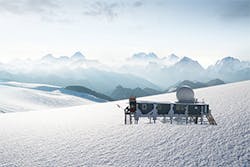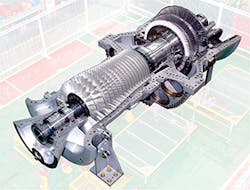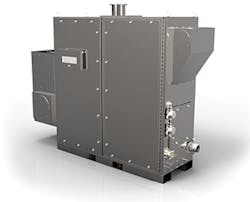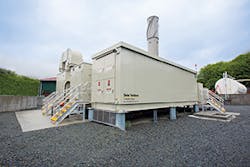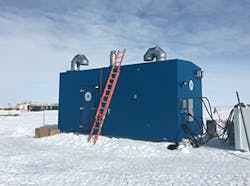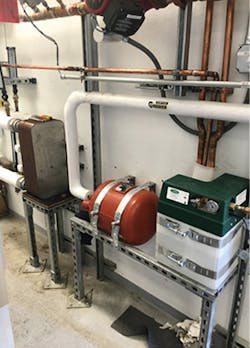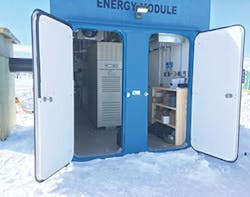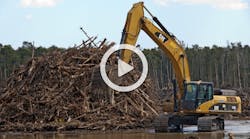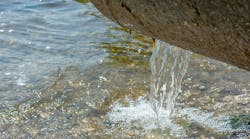Selecting a turbine to fit the environment it will operate in is really all about designing the right air filtration system to protect the gas turbine and compressor components. Filtration systems should be adapted to the specific site conditions to provide the best possible protection and optimized engine performance.
There is no “all-in-one” filter. There are typically pre-filters and specialized filters, which the turbine manufacturer, the air filter manufacturer, and the engineering firm hired by the customer, design together.
We spoke with representatives from four turbine manufacturers, Solar Turbines, Mitsubishi Hitachi Power Systems, Siemens, and Capstone Turbines. Their advice for placing turbines in extreme environments was strikingly consistent.
The Turbine Manufacturers
Solar Turbines, headquartered in San Diego, CA, manufactures turbine generators ranging from 1.1 MW to 22 MW, making them ideal for industrial and cogeneration, or combined heat and power applications.
Dr. Rainer Kurz, systems analysis manager at Solar Turbines, says that the company’s gas turbines have been installed in many challenging environments. A large number are operating in the Middle East, Alaska, southern US, South America, and southeast Asia—the areas where extremely hot or cold, windy, and dusty conditions could affect turbine performance.
Solar Turbine engineers design the special requirements for the air inlet systems for the turbine packages going to these challenging environments, says Kurz. The turbine itself doesn’t change.
The discussion with Dr. Kurz was supplemented below with excerpts from a paper he wrote with Melissa Wilcox and Klaus Brun, both with the Southwest Research Institute. The paper, “Successful Selection and Operation of Gas Turbine Inlet Filtration Systems” was published in 2011 in the Proceedings of the Fortieth Turbomachinery Symposium.
Todd Shaw, director of industrial gas turbine products at Mitsubishi Hitachi Power Systems, says that a broad spectrum of customers buy its small- and medium-sized gas turbines, ranging from 28 MW to 101.3 MW. Customers buy them for traditional power generation, as well as for behind-the-fence applications such as in-house cogeneration for power generation as well as for waste heat applications using the exhaust heat.
These gas turbines are also popular with independent power producers looking to diversify their business by selling power through power purchase agreements and steam through long-term purchase agreements with steam hosts, says Shaw.
Dalia El Tawy, Siemens senior marketing manager, says that the company’s industrial and aero-derivative gas turbines, which range from 4 MW to 66 MW, can be used in simple cycle, combined heat and power and cogeneration, or combined cycle applications for power generation in power plants as well as in industrial and commercial applications, and for district heating where steam or hot water is required.
Jim Crouse, executive vice president at Capstone, which manufactures air-bearing microturbines in scalable models from 30 kW to 30 MW, says “We have field engineering teams that work with distributors who identify environmental issues.” The engineers have several methods that they use to protect their microturbines in unusual environments.
A Filter Tutorial
Filters available today are much more capable of capturing very small particles—less than one micron—to prevent fouling and corrosion. Erosion can occur when solid or liquid particles of 10 microns or larger impact rotating or stationary surfaces in the gas turbine. Once corrosion and erosion are found in the turbine or in the compressor section, the damage is irreversible and they must eventually be replaced.
The majority of modern inlet filtration systems have multiple filtration stages and must be selected based on the desired performance of the filtration system and the local environment where the gas turbine operates.
Given that the better the filter, the faster it fouls up, self-cleaning filters provide an advantage, says Kurz. They feature cartridges, which can be cleaned by blowing compressed air backwards, sucking the particles out.
Self-cleaning filters are particularly helpful in desert areas where dust loads can range from mild to fairly high dust storms. Non-self-cleaning filtration systems can quickly become loaded and require frequent filter changes, increasing maintenance and labor costs.
HEPA, EPA, and ULPA are high-efficiency filters that are used to remove the smaller particles that lead to corrosion, fouling, and cooling passage plugging. They need prefilters to take up the courser materials, Kurz says. They are not self-cleaning.
The difference between the three filters is based on efficiency. EPA and HEPA filters have an efficiency of 85% and 99.95% respectively. ULPA filters have a minimum efficiency of 99.9995% for particles 0.12 microns or larger in size. Since fouling on compressor airfoils can be removed by water washing, using filters with higher efficiencies can increase the intervals between water washes.
Hot Areas
There is an estimated power drop of 0.3% to 0.5% per degree fahrenheit as ambient temperatures increase. Evaporative cooling or fogging in the turbine’s air inlet is a typical solution in hot arid areas. Water droplets are sprayed into the engine’s air inlet to lower the temperature. Kurz cautions that the water has to be extremely clean. Adding water treatment increases costs to operations and maintenance expenses, he says.
However, if the air is humid, evaporative cooling won’t work as well. In this case a small chiller or cooling coils can be installed in the engine inlet system. This installation adds costs, Kurz warns. The cooling coils require electricity to operate and although the cooling will increase power output, a small amount will go to operating the cooling coils. In terms of economics, using a chiller with a 100-MW turbine will be economic, but for a 5-MW turbine its use may not make sense.
In tropical environments where there is a large amount of rain, weather hoods are the basic protection. Insect screens are used to block insects. They have lower air velocity, which allows insects to move away, thereby preventing obstruction of the inlet airflow.
Mitsubishi Hitachi Power System’s 28-MW H-25 gas turbine has been in operation since 1988 and is designed for various applications including cogeneration and independent power plants.
Mitsubishi Hitachi Power Systems
(MHPS) offers particular design options for severe environments with their H series turbines. Shaw agrees with the solutions Kurz discusses regarding hot environments. Chilling coils, once they are installed in the inlet filter house, will reduce the inlet air temperature andincrease turbine performance. Another option would be evaporative cooling included in the inlet filter house which could be used for a less extreme, hot environment, he says. However, evaporative cooling is not as effective in areas with high humidity.
Crouse says in hotter environments, the air going into the turbine should be filtered as thoroughly as possible. Using prefilters that can be changed while the turbine is in operation extends the life of the main engine filters and reduces maintenance.
In a humid environment, a coating of grease can be applied that prevents moisture from getting into the electronics and electrical connections, says Crouse.
Coastal And Wet Environments
For turbines operating in a coastal area, special filter media and filter designs, such as self-cleaning filters, will ensure the quality of the air entering the turbine and eliminate any salty elements. Alerts can be programmed into the control system to let the operating crew know when to change the filter elements.
Also, says El Tawy, special stainless steel casings can be used to cover component parts where there are concerns about corrosion. She says it is critical to assess the necessary requirements in the early phases of the design to specify the equipment properly. Over specifying can drive the cost up unnecessarily. Under specifying can result in significant quality and reliability issues. Key collaboration between the end-user, the original equipment manufacturer, and the engineering team can avoid these problems.
Wind And Dust
If the gas turbine will be operating in a windy and dusty area, Shaw says there are a couple of options for maintaining proper operation. An additional self-cleaning filter or a HEPA filter can be added to the standard fine filter in the inlet filter house. Another option is to use a compressor water wash system that improves compressor efficiency.
Cold Environments
El Tawy says that when gas turbines and their components are installed in harsh environments, the key is to specify the equipment properly for the environment the turbine will operate in. Operating conditions have to be considered at the design level.
Gas turbines operating in exceptionally cold environments are typically installed in a building, or room within a building. Heating inside the building, as well as heating the room where the gas turbine is housed, is typically needed to allow the equipment to operate properly, assuming the cold temperature is consistent for a long time. The more assured solution is to heat the incoming air with exhaust heat coming off the back of the turbine.
David McDeed, senior product manager for GTCC products, says MHPS has experience installing its turbines in cold climates. In such cases, anti-icing equipment is incorporated into the design—commonly known as inlet-bleed heating—where hot air is extracted from the turbine compressor discharge and returned to the inlet filter house. Another option for more extreme environments would be to design a system that heats inlet air before the turbine starts, explains McDeed. An auxiliary boiler, diesel-fueled cogeneration unit, or other large heat source would be needed to provide that heat.
According to Kurz and his co-authors, ice buildup is the primary concern in arctic environments. Ingestion of snow or freezing rain and depression of cool, humid air in the inlet system can be avoided with weather or snow hoods. Self-cleaning filters can usually protect against snow and freezing rain.
Anti-icing protection is used to prevent the depression of cool, humid air. Without protection, inlet ducts or the gas turbine compressor can be damaged.
Off The Grid in Russia
Capstone turbines are supplying all the electricity and heat needed at Sport Center Igora, a ski resort in Russia where 38 microturbines, operating on liquefied methane, are providing power to the lodge, other buildings, and the ski lift. The lodge is located 54 kilometers from St. Petersburg—and the nearest power line.
Thirty Capstone C60 and eight C65 microturbines provide 2.32 MW to cottages, office buildings, cafes, restaurants, and a skating rink. At night, they illuminate the ski slopes in addition to the lodge and ski lift. The waste heat from the microturbines heats the buildings and supplies hot water in a combined heat and power or cogeneration operation. The system uses a Russian-manufactured heat exchanger.
According to Capstone, the system, in operation since September 2008, has experienced 100% reliability since being commissioned.
Valeriy Ignatenko, chief power engineer, was quoted by Capstone as saying, “The ski resort is far from the utility grid, so connection to the grid would be very problematic and not economically viable.” He also says the ski resort does not have access to natural gas, hence its use of liquefied methane—the most economically viable fuel for the sport center. The microturbines can also run on liquefied propane-butane as a backup fuel.
Ignatenko also explains that, “Power demand at a ski resort is not uniform, since power needs at night are less than during the day.” Individual units in the bank of microturbines can be turned off and on as needed. He also says routine maintenance is performed just twice a year and there is no need to replace lubricants given its use of air bearings. Capstone turbines also have low emissions and noise levels, he says.
Capstone’s C65 ATEX Microturbine designed for hazardous locations, produces ultra low emissions operating on natural gas.
Emissions Controls
MHPS turbines are designed with low-emissions combustion systems. However additional emissions controls may be necessary, depending on local emissions requirements, and are available for all turbines, says Shaw. Options include selective catalytic reduction (SCRs) and carbon monoxide catalyst systems. McDeed points out that gas turbines create just a portion of the emissions that must be accounted for and controlled to meet air-quality permit requirements. Other equipment, like diesel engines and auxiliary boilers at the site, could produce emissions that also need to be controlled and accounted for as well.
Solar Turbines uses a lean premix combustion system, SoLoNOx, for its turbines, where the fuel is burned with a surplus of air that creates a colder flame, producing less NOx. Kurz says it adds a little to the engine cost, but the maintenance requirements are essentially the same as for a standard combustor.
On the other hand, says Kurz, SCRs are bulky, expensive, and require extra maintenance. They use a catalyst to force a reaction of NOx with ammonia (NH3) that has to be injected into the catalyst. While reducing NOx, it adds a small amount of ammonia to the exhaust.
At Siemens, El Tawy points out that emissions requirements are under the control of local, regional, or state enforcement agencies and the customer and the original equipment manufacturer must consult with the appropriate agency. Different options are available for gas turbines to meet emissions requirements, says El Tawy. These include dry, low-emissions combustion systems, and selective catalytic reduction units.
The City of Sitka, AK, installed Solar Turbine’s 15-MW Titan 130 Modular Power Plant to serve an increased demand for power when its citizens switched to electric heat after fuel oil costs ballooned. The turbine utilizes Solar Turbine’s SoLoNox low-emissions combustion technology
Fuel
Fuel must also be accounted for, El Tawy says. Filtration is needed if the supply fuel includes impurities or elements that do not meet the heat content requirements specified for the turbine. Pipeline-quality natural gas has a high heat content due to the methane it contains, making it an excellent fit for gas turbines.
In cases where alternative fuels are used, the gas turbine design and supporting systems need to be reviewed to add necessary changes.
For example, coke oven gas, a byproduct of the steel industry’s use of coal to manufacture steel, is made up of 20 to 30% methane and 50 to 60% hydrogen, in addition to other gases in smaller percentages, giving it good heat content. While it is good for turbines, modifications are required, explains El Tawy. Coke oven gas must be cleaned and filtered, and a control system with software needs to include the options necessary to operate on the fuel, monitor the rate of fuel flow into the turbine, and make necessary adjustments during the operation. The control system could also initiate alarms or shutdowns to ensure safety and protect the equipment.
The Capstone generator set in its enclosure at Summit Station about 250 feet from the Science Station in the background. It sits on skids so that every few months it can be moved to get on top of the snow as other buildings are. Note the snorkels installed on top are turned down to take in air and not snow.
El Tawy adds, “Burning coke oven gas in the gas turbines to produce power is a much better alternative to flaring it. The result is significant cost savings as well as an environmentally friendly solution.”
Moving on to Capstone, Crouse explains that if the fuel the microturbine is running on is not commercial quality such as associated gas (or flare gas), fuel lines should be insulated and heated to reduce condensation in the fuel line leading to the turbine. The associated gas can have heavy hydrocarbons or moisture, and a coalescing filter will remove the largest particles. Heating the gas to 10°C above the dew point will vaporize any remaining constituents that may cool or re-condense the gas downstream.
Compressors are used in Capstone microturbines only for commercial-quality natural gas, says Crouse. For other types of gas, “our distributors work with companies that specialize in compressing and treating non-standard fuels” who can supply the fuel for the application.
Earthquakes
Foundation and seismic conditions should also be taken into consideration says El Tawy. The soil and foundation of the building where the turbine will be installed must be analyzed to avoid potential for vibrations, which might damage the equipment. Appropriate soil analysis and designing the foundation to meet necessary minimum requirements are important early steps in the power plant design, El Tawy says.
A Greenland Experiment
Greg Porter, president of Arctic Energy in Anchorage, AK, became a distributor of Capstone microturbines six years ago. Capstone turbines have been part of the oil and gas industry in Alaska for more than 10 years, for example in Point Barrow and at Erikson Air Force Base, according to Porter. Cook Inlet has probably had 60 microturbines operating for more than 10 years, as well.
Arctic Energy won a contract with the National Science Foundation (NSF) to install a Capstone microturbine in Greenland at Summit Station in Blue Power Park, NSF’s scientific station, as a “proof of concept.” Porter says “NSF chose us because the microturbine module is completely air tight and can be placed anywhere in the world.”
Porter explains that the module and the microturbine were built in Anchorage, shipped to New York, and flown to Thule, Greenland. This spring it was put on a bulldozer train and transported to Summit Station.
The model C65 has been operating in combined heat and power mode at 34 kW since spring 2016, and will reach operational status running at 65 kW this winter, Porter says.
One advantage Capstone turbines have in colder climates is that their air bearings use no oil and do not have a heat jacket. However, Porter and his colleagues had to make some modifications to allow the microturbine to operate at -20°F temperatures in Greenland. Other engineers told them it couldn’t be done since technical references list the limit of operations for most turbines.
“We were doing what was necessary in cold weather,” says Porter, adding that microturbines are more efficient in cold weather. While the microturbine is installed inside an airtight mini-building, air had to be brought into it to allow the microturbine to operate while avoiding a vacuum, which would suck snow in.
One of the conditions the Summit Station experiences is snow blowing sideways, which would obscure the air intakes on the buildings. The solution Porter and his colleagues came up with was to create multiple airways into the building. They created a “treacherous” pathway from the outside of the building where it is connected to two snorkels (just like the tool used to swim underwater) installed on the outside of the building at the top of the walls and pointing downward. The air is sucked into the building via the airway, which forces the air to go left and right, and up and down to remove the snow from the air. Porter says two more airways will be added to guarantee that the microturbine stays cold.
Normally, the -20° temperature would be dangerous to other turbine generators, but not a Capstone, says Porter. Its technical specifications limit its operation to 10,000 feet, but the Summit Station is at 10,528 feet. Weather can cause the barometric pressure to shift and when low pressure levels hover, it increases the elevation for any turbine which causes it to derate and produce less power.
Porter says at Summit Station, air pressure may increase the perceived elevation to 14,000 feet. “We can run colder and denser air, making the microturbine think it is operating at a lower elevation, bringing back its efficiency at the upper elevation, and it continues to generate its rated electricity.”
NSF operates several buildings at Summit Station and the Capstone’s exhaust heat is used to heat them. The heat, captured on top of the Capstone, is run through a glycol loop to insulated piping buried in a trench that runs to the buildings.
The Capstone microturbine and all the buildings at Summit Station sit on skids because they all have to be moved every few months to get them back on top of the snow. If they were not moved, eventually all would be buried, since Porter says, the glacier is still growing.
Capstone Turbine Corporation manufactures low-emission, high-efficiency, air-bearing microturbines. Its product lineup includes scalable models from 30 kW to 30 MW including the C65 ATEX model, designed for hazardous locations. This model offers ultra-low emissions and a purged and pressurized stainless-steel enclosure. All Capstone microturbines operate on a variety of gaseous, renewable, or liquid fuels. The company has shipped over 8,800 Capstone microturbines to customers worldwide.
Mitsubishi Hitachi Power Systems, a joint venture formed in February 2014 between Hitachi, Ltd., and Mitsubishi Heavy Industries, Ltd., offers a portfolio of gas turbine products, both large, advanced class frame turbines and small and medium class industrial frame turbines. The advanced class G series and the J series, with rated simple cycle outputs of 276 MW and 327 MW respectively, are designed for power plants. The small- and medium-sized H-25, H-50, and H-100 models, ranging from 28 MW up to 101.3 MW, are designed for various applications including cogeneration and independent power plants.
Siemens is a leading supplier of systems for power generation and transmission as well as other technologies. It offers a large portfolio of industrial and aero-derivative gas turbines, which includes a variety of gas turbine models in the power output range between 4 MW and 66 MW. Siemens also offers a comprehensive range of heavy-duty gas turbines and a line of reciprocating engines.
Solar Turbines was founded in San Diego, CA, in 1927 as Prudden-San Diego Airplane Company and initially designed, manufactured, and sold airplanes. In 1940, the company developed and manufactured the first portable gas turbine generator set for the US Navy. Since 1960, Solar Turbines has developed industrial gas turbines for both power generation and oil and gas applications. Today, Solar Turbines is the leading supplier of industrial gas turbines from 1 to 22 MW. There are more than 15,000 gas turbines installed in over 100 countries worldwide that have collectively logged more than 2 billion hours of use.
